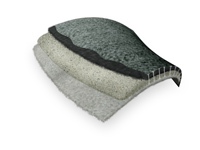BENTOMAT® Geosynthetic Clay Liners
The Global Standard for GCLs
Sodium bentonite-based GCLs provide an excellent hydraulic barrier in applications where leachate in direct contact with the GCL is relatively non-aggressive, or in composite lining applications where the GCL is overlain by a thermally welded geomembrane and hydrates from uptake of innocuous moisture from the subgrade.
Interface and internal shear strength
Depending on the site conditions, the interface and internal shear strength requirements may vary. BENTOMAT is available in a non-reinforced configuration to allow maximum value for your site. It is also available with the industry leading highest needle-punch density providing maximum performance when high internal shear strength is needed.
Common applications for BENTOMAT GCLs
|
|
|
Configurations
STANDARD REINFORCED GCLs
 | DN
|
 | DN9
|
 | ST
|
 | STM
|
NON-REINFORCED GCLs
 | 200R
|
COMPOSITE LAMINATE GCLs
 | CLT
|
 | CL
|
 | 600CL (non-reinforced)
|
- Case Study: Bailey Mine Tailings Pond - BENTOMAT® SDN 527 KB
- Case Study: BENTOMAT® AS GCL as Embankment Liner for Zaragoza, Spain High Speed Railroad 1589 KB
- Case Study: BENTOMAT® DN GCL at Carlota Copper Mine Heap Leach Pad 448 KB
- Case Study: BENTOMAT® DN GCL for Barrick Goldstrike Mine Tailings Storage 1006 KB
- Case Study: BENTOMAT® SP GCL for Embankment Liner at Zosin, Poland Border 1073 KB
- Case Study: Copler Gold Mine - BENTOMAT® ST GCL 886 KB
- Case Study: Cordoba Spain High Speed Railroad Embankment Liner - BENTOMAT® AS GCL 1184 KB
- Case Study: Denison Uranium Mine - BENTOMAT® ST GCL 373 KB
- Case Study: Duck Creek Coal Ash Disposal - BENTOMAT® SDN GCL 816 KB
- Case Study: Fremont Reservoir - BENTOMAT® DN & 200R GCLs 694 KB
- Case Study: Juliana Canal - BENTOMAT® 4000 GCL 2009 KB
- Case Study: Karns Meadow Stormwater Liner - BENTOMAT® CL GCL 733 KB
- Case Study: New Jersey Brownfield Redevelopment - BENTOMAT® SDN GCL 830 KB
- Case Study: Suncor Oil Sands Tailings Pond Liner - BENTOMAT® CL GCL 613 KB
- Case Study: TVA Kingston Coal Ash Storage - BENTOMAT® 600CL & CL GCLs 1151 KB
We build all of our GCLs to be compliant with GRI-GCL3 and their guide specifications can be found for use on the Geosynthetic Institute website.
Helena-Lewis and Clark National Forest Finish Repairs on Park Ditch - KTVH, June 2020 |
| CETCO Launches BENTOMAT DN-HS GCL to Achieve Superior Peak Shear Strength Properties - CETCO, February 2020 |
| Creating a Garden Pond: How to Choose the Right Lining - Telegraph, September 2015 |
| Design Considerations for GCLs in Leach Pad Liner Systems - Geosynthetics Magazine, October 2014 |
| Dynamic Shear Strength of Geosynthetic Clay Liners - Geosynthetics Magazine, October 2013 |
| Evaluations of Engineered Cover Systems for Mine Waste Rock and Tailings - Geosynthetics Magazine, June 2013 |
| Static Shear Strength of Geosynthetic Clay Liners - Geosynthetics Magazine, February 2013 |
| New Geosynthetics Advocacy Aimed at State and Local Levels - Geosynthetics Magazine, February 2013 |
| Shear Strength of Geosynthetic Clay Liners: Part 1 - Strength Measurement - Geosynthetics Magazine, October 2012 |
| Use of Geosynthetics in Deicing Facilities at the Cleveland Airport - Geosynthetics Magazine, June 2007 |
- BENTOMAT DN-HS GCL Technical Data Sheet 207 KB
- Technical Data Sheet: BENTOMAT® 200R GCL 189 KB
- Technical Data Sheet: BENTOMAT® 600CL GCL 272 KB
- Technical Data Sheet: BENTOMAT® CL GCL 266 KB
- Technical Data Sheet: BENTOMAT® CLT-20 GCL 275 KB
- Technical Data Sheet: BENTOMAT® DN GCL 188 KB
- Technical Data Sheet: BENTOMAT® FLW GCL 191 KB
- Technical Data Sheet: BENTOMAT® ST GCL 189 KB


